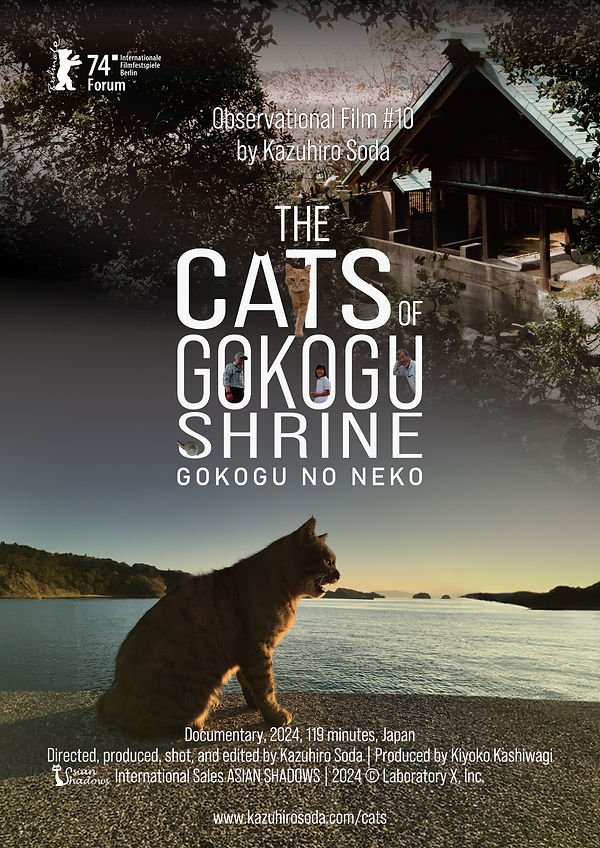The Cats of Gokogu Shrine (Gokogu no Neko)
想田和弘 観察映画第10弾『五香宮の猫』
Observational Film #10
2024, 119 minutes, Documentary
Berlin International Film Festival
World Sales: Asian Shadows

Synopsis
Gokogu is a small, ancient Shinto shrine in Ushimado, Japan, on the Seto Inland Sea. Home to dozens of street cats, it is also known as “Cat Shrine.”
Many people visit the shrine for various reasons: some to worship gods, others to enjoy gardening. Some people come to clean the shrine as volunteers while others just stop by on their way to fish Japanese sardinella –– and it is the perfect place for kids to play after school. In addition, some people visit Gokogu to feed the freely roaming stray cats. Others just come to see these cats or to take pictures of them. It is a heaven for cat-loving residents and visitors, but some residents complain about the waste the cats leave around the neighborhood. Gokogu looks peaceful on the surface, but it is also the epicenter of a sensitive issue that divides the local community.
In 2021, after living in New York City for 27 years, Kazuhiro Soda and Kiyoko Kashiwagi relocated to Ushimado where they had previously filmed Oyster Factory (2015) and Inland Sea (2018). As new settlers, the couple tries to blend into Ushimado’s local community, and gets caught up in the problem around the cats of Gokogu. The filmmakers started rolling their camera to observe and depict the aging, traditional community and its spiritual center Gokogu. The result is a beautiful and cruel, simple yet complex portrayal of the universe of Gokogu, interwoven with people, cats, and all living beings.


Director’s Statement
By a turn of fate and coincidences, we ended up shooting Oyster Factory (2015) and Inland Sea (2018) in Ushimado by the Seto Inland Sea in Japan. Back then, Kiyoko Kashiwagi, my wife and producer, and I were comfortable living in New York, and never dreamt that we would move to Ushimado in a few years.
But the coronavirus pandemic profoundly changed our attitude towards life. In 2021, after 27 years in New York, we relocated to Ushimado. We didn’t want to continue living in a big city covered in concrete, so disconnected from nature. Instead, we wanted to try living in harmony with nature, surrounded by the sea and mountains.
A little while after we settled in Ushimado, the shooting of The Cats of Gokogu Shrine began unexpectedly.
Kiyoko and I encountered two cat brothers, Chataro and Chibishima, on the street. They were injured and starving, so we felt compelled to look after them with the help of a local activist who had been feeding and protecting Ushimado’s local street cats. In return, Kiyoko volunteered to help him capture and fix the cats of Gokogu, which made me start rolling my camera.
While shooting at Gokogu, I discovered that the shrine was a unique public space where many people came and went for various reasons. I also became aware that while there were people who took care of the street cats, some residents harbored negative feelings toward them because of the mess their waste left in the neighborhood. Gokogu seemed to be the epicenter of a sensitive issue that divided the local community. Drawn in by the allure of the place, I found myself shooting at Gokogu for about two years.
Like my previous films, The Cats of Gokogu Shrine was shot spontaneously without a plan or prior research, following my “Ten Commandments of Observational Filmmaking.” Because Kiyoko’s involvement with the situation was what initiated my shooting, she naturally became a character in the film. As a result, the line between filmmakers and characters became ambiguous, which made this film a good example of “participant-observation.”
Living in Ushimado, I often contemplate the relationship between human beings and nature, a relationship that often seems to be on a course towards collapse. Observing the street cats of Gokogu, I realized that they haven’t lost their sense of wilderness. They are part of nature. In this sense, The Cats of Gokogu Shrine is a film which observes and examines the complex relationship between human beings and nature.
"Ten Commandments"
1 No research.
2 No meetings with subjects.
3 No scripts.
4 Roll the camera yourself.
5 Shoot for as long as possible.
6 Cover small areas deeply.
7 Do not set up a theme or goal before editing.
8 No narration, super-imposed titles, or music.
9 Use long takes.
10 Pay for the production yourself.







Poster image designed by Yumi Yoshino